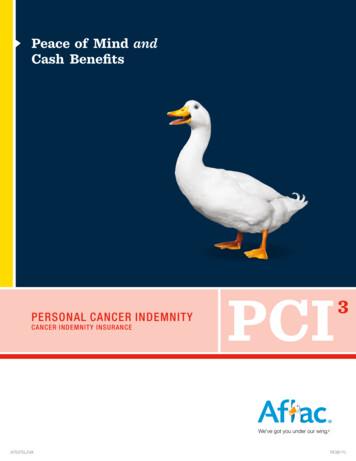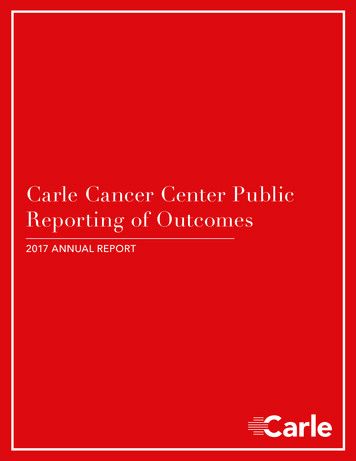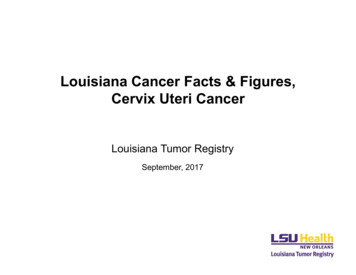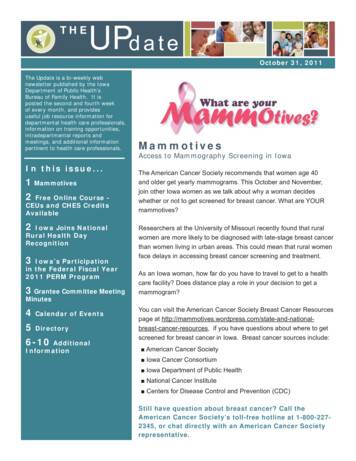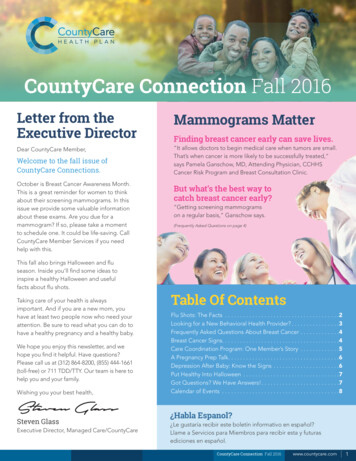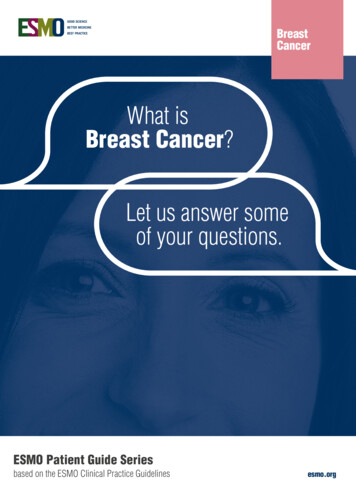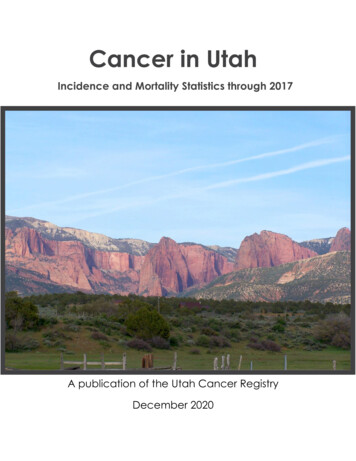
Transcription
1Men’s Information-Seeking Behaviour Regarding Cancer Risk and Screening:2A Meta-Narrative Systematic Review34Mohamad M. Saab*1, Mary Reidy1, Josephine Hegarty1, Mairin O’Mahony1, Mike Murphy2,5Christian Von Wagner3, Frances J. Drummond1,4671School of Nursing and Midwifery, University College Cork, Ireland82School of Applied Psychology, University College Cork, Ireland93Institute of Epidemiology and Health Care, University College London, United Kingdom104Department of Epidemiology and Public Health, University College Cork, Ireland13*Corresponding author at: Catherine McAuley School of Nursing and Midwifery, University14College Cork, Brookfield Health Sciences Complex, College Road, Cork, Ireland.15Tel.: 353 21 490 151816E-mail address: msaab@ucc.ie; mohamad.m.saab@gmail.com11121718192021222324251
1ABSTRACT2Objective: Preventive strategies are known to reduce cancer risk and incidence and improve3prognosis. Men seldom seek medical information about cancer prevention and risk reduction.4The aim of this meta-narrative systematic review was to critically appraise evidence from5qualitative, quantitative, and mixed-methods studies that explored men’s information-seeking6behaviours in relation to cancer prevention and risk reduction.7Methods: MEDLINE, CINAHL Plus with Full Text, PsycINFO, PsycARTICLES,8Psychology and Behavioral Sciences Collection, Education Full Text, and ERIC were9systematically searched for studies published in English between January 1st 2006 and May1030th 2016. A total of 4,117 titles were identified; of which, 31 studies were included (2111qualitative studies, nine quantitative studies, and one mixed-methods study). The12methodological quality of the studies was appraised using different tools.13Results: Most studies focused on screening for prostate (n 18) and colorectal cancer (n 7).14The majority of men were passive information-gatherers rather than active information-15seekers. Key sources of information included the internet for active information-seekers and16healthcare professionals for passive information-gatherers. Barriers to information-seeking17included information overload, embarrassment, and fear. Low literacy and health literacy18levels were addressed in three studies and were identified as impediments to active19information-seeking. Facilitators to information-seeking included family support, media,20celebrity endorsements, and targeted information.21Conclusions: Men’s information-seeking behaviour regarding cancer risk reduction,22prevention, and screening is influenced by several factors. This necessitates targeted23interventions aimed at raising awareness of cancer prevention and screening, whilst24accounting for men’s informational needs, preferred learning strategies, and literacy levels.25Keywords: cancer; colorectal cancer; health literacy; information-seeking; men; oncology;26prevention; prostate cancer; screening; systematic review.272829302
1INTRODUCTION2Cancer remains one of the leading causes of mortality and morbidity around the world.13Fourteen million new cancer cases and 8.2 million cancer deaths were recorded worldwide in42012.1 It is expected that cancer incidence will increase by 70% over the coming two5decades.1 Cancer incidence and mortality are higher among men in comparison to women.26The most commonly diagnosed cancers in men are lung, prostate, colorectal, gastric, and7liver cancer.1,28Preventive strategies have been shown to reduce the risk of cancer and have been linked to9improved prognosis.3 Nelson et al. reported a statistically significant decrease in breast cancer10mortality in women aged 50 to 69 years who were screened compared to those who were11not.4 Similarly, a randomised controlled trial with 30-year follow-up found that faecal occult12blood testing reduced colorectal cancer mortality significantly when performed annually or13biennially.5 While widespread, the effect of prostate cancer screening on mortality remains14controversial.6,7 Other preventative strategies, including national smoking bans, have resulted15in decreased smoking-related mortality.8 In order for preventative strategies to be effective,16health information needs to reach, engage, and be understood by the target population.17In their analysis of the concept “health-seeking behaviour”, Lambert and Loiselle described18health-seeking behaviours as “ways in which individuals go about obtaining information,19including information about their health, health promotion activities, risks to one’s health,20and illness” (p.1008).9 Health-seeking can be undertaken when people are asymptomatic,21with a view to prevent disease.1022A range of information-seeking behaviours have been described, including active23information-seeking (i.e. actively and with purpose seeking out information regarding a24specific issue); active monitoring (i.e. actively scanning one’s environment for information,25cues regarding a particular issue); passive monitoring (i.e. relying on chance encounters and26other individuals to provide unsolicited information); and proxy searching (i.e. using27intermediary channels such as friends or family members to search for information about an28issue on behalf of the individual).1129The literature reports that men seek health information less often than women.12,13 Moreover,30men are more likely to engage in passive information-gathering, whereas women are more31likely to be active information-seekers.13-153
1Men’s lack of information-seeking is believed to be one of the leading causes for2deprioritising men’s health promotion among service providers and assuming that gendered3approaches to health should be primarily focused on women, rather than both genders4equally.16-18 This, according to Leone and Rovito, negatively impacts on men’s engagement5with health services and increases the health gap between both genders.19 In fact, men are less6likely to participate in preventative healthcare activities, including cancer screening, than7women,20 and are known to delay medical help-seeking for symptoms of male-specific,21 and8non-gender-specific malginancies.229In order to inform future health promotion policy and positively affect men’s health, it is10necessary to understand men’s health information-seeking behaviour in relation to cancer11prevention and risk reduction. To the authors’ knowledge, there has been only one systematic12review that focused on prostate cancer information.23 Therefore, the aim of this meta-13narrative systematic review was to critically appraise evidence from qualitative, quantitative,14and mixed-methods studies that explored men’s information-seeking behaviours in relation to15cancer prevention and risk reduction. This review was conducted based on five predefined16questions as follows:17(i) Where do men seek information on cancer prevention and risk reduction?18(ii) How do men use information on cancer prevention and risk reduction?19(iii) What are the barriers to information-seeking?20(iv) What are the facilitators to information-seeking?21(v) What is the impact of health literacy on information-seeking and use?2223METHODS24This meta-narrative systematic review was conducted in accordance with the Cochrane25Handbook for Systematic Reviews,24 and reported using the 20-item Realist And MEta-26narrative Evidence Syntheses: Evolving Standards (RAMESES) reporting tool.25 Meta-27narrative review is a relatively recent systematic review methodology aimed at reviewing28evidence from qualitative and mixed-methods studies and is best suited for topics that have29been differently conceptualised.25 The review questions and methods were pre-defined and30were not changed during the review process.31Eligibility criteria4
1Empirical studies considered for inclusion met the following criteria: (i) involved men; (ii)2adults (i.e. aged 18 years); (iii) primarily focused on where and how men seek and use3information on cancer prevention and risk reduction; (iv) published between January 1st 20064and May 30th 2016; and (v) published in English. Although there is no golden rule for5limiting publications by date, scientific evidence published within a 10-year timeframe is6considered to be recent.26,27 Eligible studies were included regardless of their methodological7quality, since excluding studies on the basis of their methodological quality increases the risk8of study selection and reporting bias.249Studies involving women exclusively or where findings from men and women were10indistinguishable were excluded. Studies involving cancer survivors were also excluded since11their experiences may differ from those without cancer. Opinion papers, policy reports, and12conference abstracts were excluded as their methodological quality could not be appraised.13Dissertations and theses were excluded, since the merit of using them in systematic reviews is14inconclusive.2815Information sources and search strategy16A systematic search of relevant electronic databases over a 10-year period was conducted.17The electronic databases searched were: MEDLINE, CINAHL Plus with Full Text,18PsycINFO, PsycARTICLES, Psychology and Behavioral Sciences Collection, Education Full19Text, and ERIC. Each database was searched on May 30th 2016 for papers published between20January 1st 2006 and May 30th 2016. Reference lists of eligible studies were checked for21potentially relevant references that were not identified during the database search.22Boolean terms “OR” and “AND”, Medical Subject Headings (MeSH), and truncation “*”23were used and the search was conducted on title or abstract as follows: (men OR males OR24man OR male) AND (inform* OR advice OR advis* OR educat*) AND (cancer* OR25neoplas* OR oncolog* OR tumour* OR tumor*) AND (need* OR necessit* OR require* OR26seek* OR look* OR search* OR acquir* OR learn* OR "engag* with" OR use OR using OR27utilis* OR utiliz*) AND (prevent* OR "reduc* risk" OR minimis* OR minimiz* OR "health28promot*" OR screen*).29Study selection30Records identified through database searching were exported to Covidence, an online service31recommended by Cochrane to facilitate data screening and extraction.29 Studies were first5
1screened on title and abstract to determine whether they met the inclusion criteria. The full-2texts of potentially relevant papers were then evaluated and reasons for excluding each article3were recorded. Title, abstract, and full-text screening were conducted independently by4paired reviewers. Disagreements were resolved by consensus and involved a third reviewer5when needed.6Data collection process7Data from included studies were extracted by all authors using a predefined extraction table.8Data were extracted as follows: author(s) and year; country and setting; study aim(s); study9design and theoretical underpinning; data collection method and instruments; and findings10relating to the review questions. The table was cross-checked for accuracy by the first author.11Critical appraisal12The choice of tools to appraise the methodological quality of the reviewed studies was13dependent on the study design. The 14-item Quality Assessment Tool for Observational14Cohort and Cross-Sectional Studies was used to critically appraise the quality of quantitative15studies.30 The overall quality of each study was rated as either ‘Poor’, ‘Fair’, or ‘Good’. The16quality of qualitative studies was appraised using the 10 items of the Critical Appraisal Skills17Programme (CASP) Qualitative Checklist.31 The Mixed Methods Appraisal Tool (MMAT)18comprising 13 questions in relation to the appropriateness of the qualitative methods,19quantitative methods, and the combination of both, was used to appraise the quality of mixed-20method studies.32 Each item in all three tools was evaluated on a ‘Yes’ and ‘No’ basis. Only21the Quality Assessment Tool for Observational Cohort and Cross-Sectional Studies enabled22an overall quality rating.3023Synthesis of results24Data synthesis was conducted by the first author and cross-checked by the last author.25Findings were analysed and synthesised thematically according to the review aims.26Information-seeking behaviours were characterised as ‘active information-seeking’ and27‘passive information-gathering.’ Active information-seeking was defined as purposely28seeking out information and/or actively scanning one’s environment for information (i.e.29solicited information). Passive information-gathering was defined as relying on accidental30encounters and other individuals, including healthcare professionals, to provide unsolicited6
1information, and/or using intermediaries, such as friends and family members, to seek2information on behalf of the individual.113Use of information to make a decision regarding cancer screening was investigated and4factors influencing information-seeking were classified as barriers and facilitators. These5pertained to information format, content, amount, and source.6Finally, the impact of literacy and health literacy on information-seeking and use was7addressed. Health literacy was defined as the degree to which men were capable of obtaining,8processing, and understanding information on cancer prevention and risk reduction.33910RESULTS11Study selection12The study identification, screening, and selection processes are presented in Figure 1.3413Overall, 4,117 titles were identified through electronic database searching from MEDLINE14(n 2,528); CINAHL Plus with Full Text (n 775); PsycINFO (n 670); PsycARTICLES15(n 56); Psychology and Behavioral Sciences Collection (n 37); Education Full Text (n 28);16and ERIC (n 23). Following deletion of duplicates, 3,374 records were screened on title and17abstract and 3,054 irrelevant records were excluded. The full-texts of 320 papers were then18evaluated and 289 articles were excluded. In total, 31 papers were deemed eligible for19inclusion; 21 qualitative studies, nine quantitative studies, and one mixed-methods study. No20additional studies were identified from reference list-checks.21Study characteristics22Study characteristics are presented in Table 1. The majority of the studies were conducted in23the United States (n 20). Most of the participants were recruited from the community (n 12)24and primary care practices and screening centres (n 7). Ten studies were underpinned by a25theoretical framework. The minimum sample size for men was 835,36 and the maximum was264,194.37 Ages ranged between 1938 and 95 years.39 The majority of men were White (n 21).27Studies focused primarily on information about prostate cancer and Prostate Specific Antigen28(PSA) testing (n 18), followed by colorectal cancer (n 7).29Critical appraisal7
1The qualitative studies had clear aims and findings and used appropriate methods, designs,2recruitment strategies, data analysis frameworks, and measures to enhance rigour.31 All but3one qualitative study40 failed to address the relationship between the researcher and study4participants, which increases the risk of bias (see supplementary Table 1S). The quantitative5studies were rated as ‘Poor’ (n 4); ‘Good’ (n 3); and ‘Fair’ (n 2). Studies rated as ‘Poor’6failed to justify the sample size, specify the data collection timeframe, use valid and reliable7data collection instruments, assess outcomes more than once, and/or adjust for confounders8(see supplementary Table 2S).30 The mixed-methods study met all but one MMAT criterion,9namely sample representativeness, since the quantitative element of this study was a pilot-test10(see supplementary Table 3S).4111Synthesis of results12For results from individual studies, see supplementary Table 4S.13Information-seeking behaviours and information sources14Men either sought information on cancer prevention and risk reduction themselves i.e. active15information-seeking, or came across information i.e. passive information-gathering. In the16majority of cases, the latter was true.17Active information-seeking18Men were predominantly active information-seekers in six studies: two qualitative and one19quantitative longitudinal study assessing information-seeking for prostate cancer screening42-204421and one qualitative study on information-seeking for skin cancer prevention.4622The internet served as the primary source of information among active seekers in five23studies.37,42,43,45,46 Men searched for information on the internet to manage uncertainty24following a high PSA test43 or to learn about the cancer diagnosis of a family member.42,4525Additionally, 61% of participants in a cross-sectional study actively sought general cancer26information online.37 Haluza and Cervinka surveyed 193 men and 363 women about the27impact of skin health information on their sun protective behaviours.46 It was found that28women were more likely than men to seek information on skin cancer prevention using the29internet (36.1% for men vs. 24.7% for women; p 0.004). Other than the internet, 11% of30participants in the longitudinal study by Gibson et al. actively sought PSA testing information31from non-medical sources, including family, friends, and co-workers.44 Hicks et al. also; one cross-sectional37 and one qualitative study on general cancer information-seeking45;8
1found that men’s social networks were identified as important sources of information,42 while2participants in the study by Biddle et al. actively sought PSA testing information from3“medical journals, newspapers, television, media, chat rooms, and medical brochures” (p.6)4as well as their family, friends, and men who had similar experiences.435Passive information-gathering6Men passively acquired information in 13 studies: four quantitative,47-50 two qualitative,51,527and one mixed-methods study41 on prostate cancer screening; three qualitative studies 35,36,538and one quantitative study on colorectal cancer screening39; one quantitative study on Human9Papilloma Virus (HPV) and anorectal cancer prevention54; and one qualitative study on10general cancer information.5511Healthcare professionals were identified as a major source of unsolicited health information.12For instance, participants in two qualitative studies identified their physician as the primary13source of information about colorectal cancer.35,53 Blackwell et al. surveyed 89 men who14have sex with men about their awareness of HPV and anorectal cancer. 54 It was found that 4915participants had heard of anal Pap smears from different sources including their primary care16physician (10.2%), nurse (16.3%), and other healthcare professionals (32.7%).54 This was17also the case in five studies on prostate cancer prevention and PSA testing.41,47,48,51,5218Men also identified numerous and varied nonmedical sources of passively acquired19information including: friends, family members, and spouses39,41,49,52,54; mass media41, 52-54;20their churches41,51; personal stories53; and medical posters.5521Use of information22Four studies addressed men’s use of acquired information to make informed decisions23regarding cancer prevention and risk reduction practices. Of those, one was a qualitative24study42 and one was a quantitative study on prostate cancer screening50; one quantitative25study addressed colorectal cancer screening39; and one quantitative study explored general26cancer information-seeking.3727In a cross-sectional study aimed at exploring general cancer information-seeking in Australia,28Zajac et al. found that men were less likely to search for information than women, but were29more likely to be open to receiving unsolicited information (both p 0.001).37 However, only3032% of men expressed their willingness to receive unsolicited information via the internet.379
1Being equipped with information on cancer prevention and screening and having a close2relative with a malignancy did not serve as predictors for prostate cancer screening3behaviours.42 Similarly, a cross-sectional study examining the relationship between family4support and PSA testing among men (n 625) found that those with a family member who had5been diagnosed with prostate cancer were less likely to have undergone PSA testing in the6previous year (odds ratio 0.47, 95% CI 0.31 to 0.70; p 0.001).507Of note, prostate cancer screening remains controversial with conflicting evidence regarding8the effectiveness of screening on reducing prostate cancer mortality.6,7 Furthermore, the9opinions and screening behaviours of healthcare professionals differ, making the decision to10undergo prostate cancer screening a difficult one for men.5611As for colorectal cancer, “information-seeking by others was associated with greater absolute12perceived risk of colon cancer, and information-seeking for oneself was associated with more13frequent worry about colon cancer” (p.73).3914Barriers to information-seeking15Barriers to information-seeking with regards to prostate cancer screening and PSA testing16were addressed in eight qualitative,39,40,42,57-61 one quantitative,44 and one mixed-methods17study.41 Barriers involved: information format and quantity (print and radio advertisements18that are either lacking in or flooded with information ‘information overload’); information19content (trigger words such as ‘research program’ and ‘research subjects’)38; lack of trust in20the information offered by the media57; and anxiety and fear.5821Barriers to information-seeking were more pronounced among men belonging to some ethnic22groups (i.e. Filipino, African American, and Latino men). In their qualitative study, Conde et23al.40 found that first generation Filipino men were more likely to ignore prostate cancer24information and Friedman et al.59 reported that African American men were primarily passive25rather than active information-seekers. Moreover, two studies identified embarrassment,26shame, perceived weakness, machoism, and fear as barriers to information-seeking in relation27to prostate cancer among African American men.41,60 Lack of awareness of the PSA test, and28cancer being a taboo subject among African American and Latino men also served as barriers29to seeking information on prostate cancer and PSA testing.41,42,59,60 One study identified low30literacy levels among African American men as a barrier to information-seeking.4131Furthermore, limited access to screening services/physicians and cost of screening were32highlighted as barriers to information acquisition among African American men.41,59,6110
1Similar barriers were reported in three qualitative studies on colorectal cancer.35,53,62 These2include: lack of information and understanding35,53; confusing instructions about faecal occult3blood testing62; generic materials being overlooked by certain cultures (e.g. American4Indian)53; fear, embarrassment, clinic location/access, and concerns about privacy and cost.535Facilitators to information-seeking6Facilitators to information-seeking in relation to prostate cancer screening were addressed in7nine qualitative,38,40,42,57-61,63 four quantitative,44,47,49,50 and one mixed-methods study.41 Many8of these facilitators pertained to information layout, content, and mode of delivery. In two9qualitative studies, men were more likely to acquire information using print media (e.g. sports10section of the newspaper), appealing videos, and bullet points61 and favoured information that11is practical and delivered via the mass media (e.g. television).63 Moreover, a number of men12preferred information targeted towards men.57,6313Men in a qualitative study who were asked to evaluate advertisements on prostate cancer14screening, requested information about the signs, symptoms, and risk factors of prostate15cancer and recommended using gender- and age-appropriate models and celebrities to16promote screening.61 This was echoed in another study, whereby men interviewed about their17prostate cancer information-seeking behaviour requested information on prostate cancer, its18risk factors, and treatment options.5819Community jurors (i.e. groups of men from the community) who evaluated different aspects20of PSA testing believed that information about the risks and benefits of prostate biopsy and21prostate cancer treatment should be offered to those who wanted it, including men with high22PSA levels.38 They also believed that men would not want such information unless it was23relevant to them.24Access to both, medical (e.g. trusted general practitioners and urologists)41,38 and non-medical25(e.g. family and friends, the church, and neighbourhood settings)59,60 sources of information26served as a facilitator to the passive acquisition of information.27Using information specifically targeted at different ethnic groups also facilitated information-28seeking and acquisition.59,61 In two qualitative studies, African American men intended to29seek information on ethnic-specific risk factors of prostate cancer,61 and recommended30prostate cancer prevention messages that are simple, direct, and specific to African American31males.59 Men also suggested that information should be delivered by trusted people including11
1African American church pastors, women, and prostate cancer survivors.59 Furthermore,2transfer of knowledge between generations,60 being a second generation Filipino man who3has computer-access,40 and living in a household that has access to information on prostate4cancer (e.g. through newspapers),47 also served as facilitators to acquiring information on5prostate cancer screening.6Four qualitative studies addressed facilitators to seeking colorectal cancer screening7information.36,53,62,64 Bennett et al. found that factual information about colorectal cancer8made screening less abstract.36 Moreover, men belonging to three different ethnic groups (i.e.9African American, English Caribbean, and Haitian) recommended pamphlets at the doctor’s10office, group sessions, and information and educational materials that are visual.64 Other11facilitators included: using real people in narratives to make screening more vivid36; leaflets12with information about faecal occult blood testing62; having a friend or a family member with13cancer; and using social networks to raise awareness.5314The impact of literacy levels on information-seeking and use15The impact of literacy and/or health literacy on information-seeking and use was addressed in16two qualitative studies on colorectal cancer screening,65,66 and one mixed-methods study on17prostate cancer screening.4118Smith et al. explored, qualitatively, the colorectal cancer screening information needs and19preferences of 14 men with varying literacy levels.65 Men with both high and low literacy20levels reported that health information should be direct, short, and sharp and appreciated21medical diagrams, found some of the statistics confusing and unclear, perceived some22scientific information as difficult, and suggested phone helplines as a source of information.6523Moreover, both groups perceived medical terminology as problematic; however, this was24more pronounced among the low literacy group. The lower literacy group also perceived25high-density text as off-putting, was not reassured by scientific references, and perceived26certain visual images as patronising. However, a weighing scale with ‘reasons to undergo27colorectal cancer screening’ on one side and ‘reasons not to undergo colorectal cancer28screening’ on the other side was perceived as helpful. Men with high literacy levels were29reassured by scientific references and appreciated the use of visual images.6530Friedman et al. conducted a mixed-methods study to assess functional health literacy among3125 African American men using two modified Cloze tests and the Shortened Test of32Functional Health Literacy in Adults.41 Adequate comprehension of the survey tools was12
1demonstrated, with more than 56% correct answers. In addition, it was found that functional2health literacy did not differ significantly by reading level and that 25% of participants were3non-seekers of cancer information.414Finally, Smith et al. explored, qualitatively, how 12 men with low educational attainment5used an evidence-based decisional aid to make colorectal cancer screening decisions.666Understanding the purpose of the decisional aid determined how men used this information.7Some used the information to make informed decisions on undergoing colorectal screening;8some men chose to get screened because of the statistics; some chose to get screened despite9doubting the statistics; and others chose not to get screened because they believed that the10harms of screening outweighed its benefits. Moreover, some men dismissed this information11and/or questioned its validity, including those who were critical of statistics and/or lacked the12confidence to interpret statistics.661314DISCUSSION15Findings from this meta-narrative systematic review suggest that men seek information in16different ways, with the majority acquiring information passively through intermediary17channels, rather than actively seeking this information. Men’s preferred format, content, and18delivery of information were identified along with barriers and facilitators to seeking19information on cancer prevention and risk reduction.20Regardless of how men acquire information; knowledge empowers.67 Therefore, once21acquired, men can use information to make decisions about their health. In fact, the review22found that men did use information to make decisions regarding cancer screening. However,23very few studies explored the effect of literacy and/or health literacy on men’s understanding24of cancer prevention and risk reduction information, which could negatively impact decision-25making. 41,65,6626Knowledge of how and where men acquire information is required to ensure its effectiveness.27An individual’s information field is the totality of possible sources an individual may consult28and incorporates their information network. The daily sphere of information, i.e. the source of29informat
7 1 School of Nursing and Midwifery, . 8 2 School of Applied Psychology, University College Cork, Ireland 9 3 Institute of Epidemiology and Health Care . 12 13 * Corresponding author at: Catherine McAuley School of Nursing and Midwifery, University College Cork, Brookfield Health Sciences Complex, College Road, Cork, Ireland.14 Tel.: 353 .


